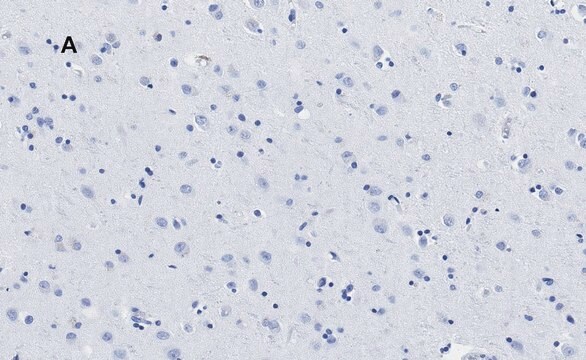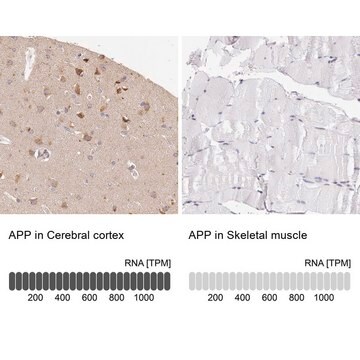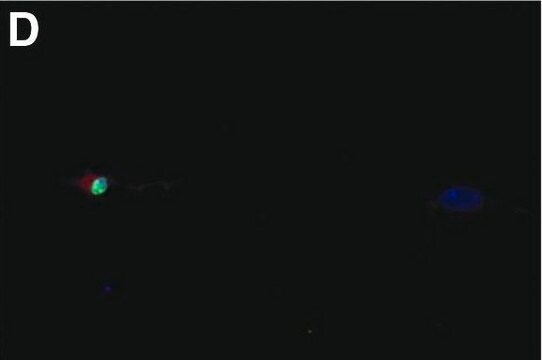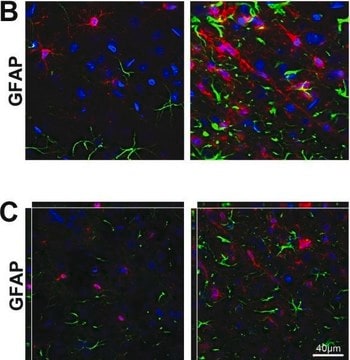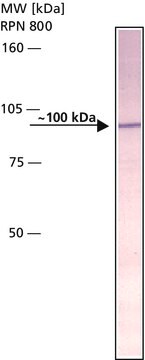MAB343
Anti-APP Antibody, APP 643-695 CT fragment, clone 2.F2.19B4
ascites fluid, clone 2.F2.19B4, Chemicon®
Sinónimos:
APP, Jonas clone
Iniciar sesiónpara Ver la Fijación de precios por contrato y de la organización
About This Item
Código UNSPSC:
12352203
eCl@ss:
32160702
NACRES:
NA.41
clon:
2.F2.19B4, monoclonal
application:
IHC
WB
WB
reactividad de especies:
rat, human
técnicas:
immunohistochemistry: suitable (paraffin)
western blot: suitable
western blot: suitable
citations:
22
Productos recomendados
origen biológico
mouse
Nivel de calidad
forma del anticuerpo
ascites fluid
clon
2.F2.19B4, monoclonal
reactividad de especies
rat, human
fabricante / nombre comercial
Chemicon®
técnicas
immunohistochemistry: suitable (paraffin)
western blot: suitable
isotipo
IgG1
Nº de acceso NCBI
Nº de acceso UniProt
Condiciones de envío
dry ice
modificación del objetivo postraduccional
unmodified
Información sobre el gen
human ... APP(351)
Especificidad
Reacts with intact full-length Alzheimer precursor protein (APP) and selectively with the cytoplasmic carboxyl fragment of APP 643-695. Epitope has reportedly been mapped in this paper http://www.impub.co.uk/abs/W386.html
Inmunógeno
Carboxyl fragment of APP 643-695 / Jonas.
Epitope: APP 643-695 C-terminal fragment
Aplicación
Immunohistochemistry on paraffin sections: 10-20 μg/mL * See protocol below.
Western blot: 10 μg/mL
Optimal working dilutions must be determined by end user.
APPLICATION NOTES FOR MAB343
IMMUNOHISTOCHEMISTRY
1) Prepare paraformaldehyde-fixed paraffin sections. Wash twice for 5 min in xylene to deparaffinize. Wash sections for 5 min in a descending series of alcohol solutions (100%, 96%, 90%, 80%, 70%, 50%, 30%).
2) Wash sections 3 times in distilled water.
3) Wash in TBS (50 mM Tris-HCl, 150 mM NaCl, pH 7.6). To block endogenous peroxidase wash with methanol containing 0.6% H2O2 (v/v) and 10 % horse serum (v/v) for 5 min at room temperature.
4) Wash sections for 5 min in TBS.
5) Incubate sections with MAB343 (diluted in TBS containing 10% horse serum (v/v)) overnight at +4°C or for 2 hours at 37°C in a humid chamber.
6) Wash sections 3 times in TBS for 5 min..
7) Detect with standard secondary antibody detection system (PAP, ABC, etc.).
8) Wash sections in TBS.
9) Embed sections and examine.
Western blot: 10 μg/mL
Optimal working dilutions must be determined by end user.
APPLICATION NOTES FOR MAB343
IMMUNOHISTOCHEMISTRY
1) Prepare paraformaldehyde-fixed paraffin sections. Wash twice for 5 min in xylene to deparaffinize. Wash sections for 5 min in a descending series of alcohol solutions (100%, 96%, 90%, 80%, 70%, 50%, 30%).
2) Wash sections 3 times in distilled water.
3) Wash in TBS (50 mM Tris-HCl, 150 mM NaCl, pH 7.6). To block endogenous peroxidase wash with methanol containing 0.6% H2O2 (v/v) and 10 % horse serum (v/v) for 5 min at room temperature.
4) Wash sections for 5 min in TBS.
5) Incubate sections with MAB343 (diluted in TBS containing 10% horse serum (v/v)) overnight at +4°C or for 2 hours at 37°C in a humid chamber.
6) Wash sections 3 times in TBS for 5 min..
7) Detect with standard secondary antibody detection system (PAP, ABC, etc.).
8) Wash sections in TBS.
9) Embed sections and examine.
Research Category
Neuroscience
Neuroscience
Research Sub Category
Neurodegenerative Diseases
Neurodegenerative Diseases
This Anti-APP Antibody, APP 643-695 C-terminal fragment, clone 2.F2.19B4 is validated for use in IH(P), WB for the detection of Alzheimer Precursor Protein.
Forma física
Liquid.
Unpurified
Almacenamiento y estabilidad
Maintain lyophilized material at +2–8°C for up to 12 months. After reconstitution maintain frozen at -20°C in undiluted aliquots for up to 6 months. Avoid repeated freeze/thaw cycles.
Nota de análisis
Control
Brain
Brain
Otras notas
Concentration: Please refer to the Certificate of Analysis for the lot-specific concentration.
Información legal
CHEMICON is a registered trademark of Merck KGaA, Darmstadt, Germany
Cláusula de descargo de responsabilidad
Unless otherwise stated in our catalog or other company documentation accompanying the product(s), our products are intended for research use only and are not to be used for any other purpose, which includes but is not limited to, unauthorized commercial uses, in vitro diagnostic uses, ex vivo or in vivo therapeutic uses or any type of consumption or application to humans or animals.
Opcional
Referencia del producto
Descripción
Precios
Código de clase de almacenamiento
10 - Combustible liquids
Clase de riesgo para el agua (WGK)
WGK 1
Punto de inflamabilidad (°F)
Not applicable
Punto de inflamabilidad (°C)
Not applicable
Certificados de análisis (COA)
Busque Certificados de análisis (COA) introduciendo el número de lote del producto. Los números de lote se encuentran en la etiqueta del producto después de las palabras «Lot» o «Batch»
¿Ya tiene este producto?
Encuentre la documentación para los productos que ha comprado recientemente en la Biblioteca de documentos.
Eun Mi Hwang et al.
Bioorganic & medicinal chemistry, 16(14), 6669-6674 (2008-06-21)
In order to access beta-secretase (BACE1), and enzyme strongly implicated in the cause of Alzheimer's disease, inhibitors must possess sufficient lipophilicity to traverse two lipid bilayers. Current drug candidates, which are almost totally peptide-derived, are thus inefficient because cell permeability
Gregory D Van Vickle et al.
Biochemistry, 46(36), 10317-10327 (2007-08-21)
We investigated the morphology and biochemistry of the amyloid-beta (Abeta) peptides produced in TgCRND8 Tg mice carrying combined amyloid precursor protein (APP) Swedish (K670M/N671L) and Indiana (V717F) mutations. Histological analyses employing amyloid-specific staining and electron microscopy revealed that the TgCRND8
Effects of peptides derived from BACE1 catalytic domain on APP processing.
Seung Woo Yeon, Yong-Jin Jeon, Eun Mi Hwang, Tae-Yong Kim
Peptides null
A TAG1-APP signalling pathway through Fe65 negatively modulates neurogenesis.
Quan-Hong Ma, Toshitaka Futagawa, Wu-Lin Yang, Xiao-Dan Jiang, Li Zeng, Yasuo Takeda et al.
Nature Cell Biology null
P Ponte et al.
Nature, 331(6156), 525-527 (1988-02-11)
The amyloid proteins isolated from neuritic plaques and the cerebrovasculature of Alzheimer's disease are self-aggregating moieties termed A4 protein and beta-protein, respectively. A putative A4 amyloid precursor (herein termed A4(695] has been characterized by analysis of a human brain complementary
Nuestro equipo de científicos tiene experiencia en todas las áreas de investigación: Ciencias de la vida, Ciencia de los materiales, Síntesis química, Cromatografía, Analítica y muchas otras.
Póngase en contacto con el Servicio técnico

